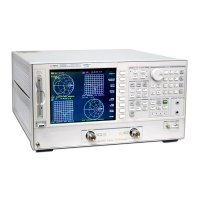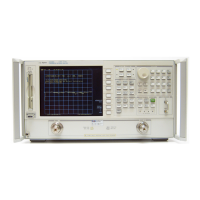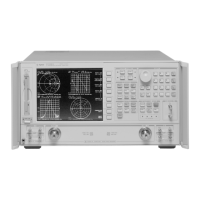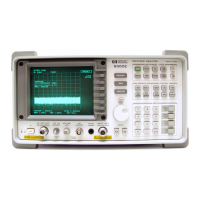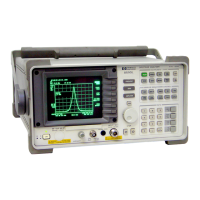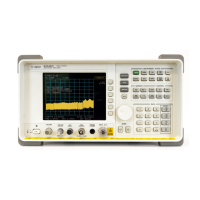Index-8
Index
multiple measurements per page from
a disk, 4-26
multiple measurements per page using
a pen plotter
, 4-18
one measurements per page using a
pen plotter, 4-17
parameters, resetting to default
values
, 4-16
plotting to an HPGL compatible
printer
, 4-19
solving problems, 4-33
plotting a measurement to a disk
to output the plot files, 4-12
polar format, 7-29
polar format markers, 1-32
port extensions, 5-5
power coupling options, 7-11
channel coupling, 7-11
test port coupling, 7-11
power meter
calibration, 2-12
calibration over IF range, 2-20
calibration over RF range, 2-23
power meter measurement calibration,
6-33
calibrating the analyzer receiver to
measure absolute power, 6-39
compensating for directional coupler
response
, 6-35
entering the power sensor calibration
data
, 6-34
interpolation in power meter
calibration, 6-34
loss of power meter calibration data,
6-33
using continuous correction mode,
6-38
using sample-and-sweep correction
mode
, 6-36
power ranges, 7-10
automatic mode, 7-10
manual mode, 7-10
power sensor calibration data, entering,
6-34
power sweep, 7-20
power, output, 7-10
primary measurement channels,
viewing, 1-12
principles, group delay, 7-32
print
aborting a process, 4-31
print function
configuring, 4-4
defining, 4-6
printer
color printer, using, 4-6
HPGL compatible printer, 4-19, 4-23
HPGL/2 compatible printer, 4-9
printing
measurement results, 4-3
multiple measurements per page, 4-8
one measurement per page, 4-7
parameters, resetting to default
values
, 4-7
sequence, 1-107
solving problems, 4-33
printing or plotting the list values or
operating parameters
, 4-32
entire list of values, 4-32
single page of values, 4-32
procedure, TRL calibration, 7-73
procedures for error correcting
measurements
, 6-10
types of error correction, 6-10
processing details, 7-7
accuracy enhancement, 7-8
ADC, 7-7
conversion, 7-8
display memory, 7-9
electrical delay block, 7-8
format, 7-9
format arrays, 7-9
gating, 7-8
IF detection, 7-7
pre-raw data arrays, 7-8
ratio calculations, 7-7
raw arrays, 7-8
sampler/IF correction, 7-7
scale and offset, 7-9
smoothing, 7-9
sweep-to-sweep averaging, 7-7
trace math operation, 7-8
transform, 7-9
vector error-correction, 7-8
processing, data, 7-6
prompting user to connect mixer test
setup
, 2-28
purging a sequence from a disk, 1-107
R
R channel inputs, internal and external,
2-10
range, 3-30
forward transform, 3-24
frequency, 1-59
resolution, 3-34
ratio calculations, 7-7
ratio measurements in channel 1 and 2,
to
, 1-20
raw arrays, 7-8
raw source match, 7-72
real format, 7-31
recall time, reducing, 5-18
recalling a file, 4-50
solving problems, 4-51
recalling instrument states, 4-34
receiver
calibration, 6-15
crosstalk, reducing, 5-14, 5-18
noise floor, reducing, 5-14
receiver block, 7-4
reducing
averaging factor, 5-11
effect of spurious responses, 2-5
number of measurement points, 5-11
reducing recall time, 5-18
understanding spur avoidance, 5-18
reducing trace noise, 5-15
activating averaging, 5-15
changing system bandwidth, 5-15
reduction, IF bandwidth, 7-37
reference plane and port extensions, 5-5
reflection measurements
response and isolation error
correction
, 6-19
response error correction, 6-12
reflection measurements in time domain
low pass, 3-16
interpreting the low pass response
horizontal axis
, 3-16
interpreting the low pass response
vertical axis
, 3-17
reflection measurements using
bandpass
interpreting the band pass reflection
response vertical axis
, 3-13
reflection measurements using
bandpass mode
, 3-12
interpreting the bandpass reflection
response horizontal axis, 3-13
reflection response measurements,
making
, 3-9
relative velocity factor, adjusting, 3-12
removing adapter delay, 6-42
removing the effect of an adapter, 6-74
renaming a file, 4-50
repeatability, connector, 5-4
repetitive switching of the attenuator,
7-14
required peripheral equipment, 7-5
required test equipment, connecting,
1-4
requirements for TRL standards, 7-73
re-saving an instrument state, 4-49
resetting
plotting parameters to default values,
4-16
printing parameters to default values,
4-7
resolution, 3-32
range resolution, 3-34
